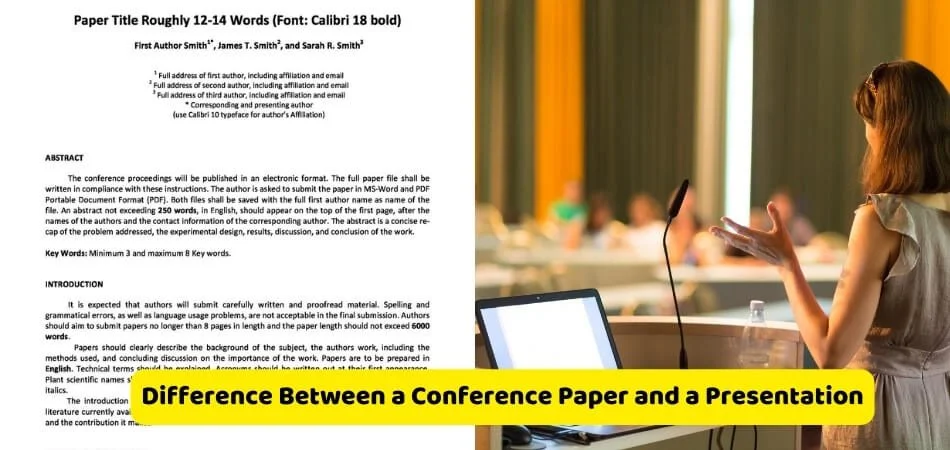In today’s academic and professional world, we often encounter various forms of knowledge sharing, two of which are conference papers and presentations. You might wonder, “What is the difference between a conference paper and a presentation?”
At its core, a conference paper is a meticulously prepared document crafted to encapsulate key findings and insights for a specific audience. It acts as the backbone for the presentation, which is a more dynamic, spoken, or visually assisted delivery of the paper’s main points.
This distinction highlights the nuanced roles each element plays in the dissemination of information. In this article, we’ll explore these differences, offering insights into how each format contributes uniquely to knowledge sharing. Join us as we explore this intriguing topic further.
A General Overview of Conference Papers and Presentation
Conference papers and presentations are pivotal in academic and professional circles, offering unique platforms for sharing research and ideas. While they may seem similar, each serves a specific purpose and audience. Understanding their differences is key to effectively utilizing both in scholarly communication.

Conference papers are detailed, written documents, meticulously prepared to encapsulate comprehensive research findings that are submitted to a conference on arts and education. They provide a structured, in-depth exploration of a topic, allowing for a nuanced and detailed presentation of the material. These papers are often peer-reviewed, ensuring their credibility and scholarly value.
Presentations, on the other hand, bring these papers to life through spoken delivery. They are designed to engage the audience, highlighting key points and creating interactive discussions. This format allows for a dynamic interpretation of the paper, making complex information more accessible and memorable to the audience.
Different Types of Conference Papers
Conference papers are a diverse bunch, reflecting the myriad ways researchers and professionals disseminate their findings. They range from theoretical explorations to case studies, each type serving a unique purpose in academic discourse. Grasping the variety of these papers is crucial for appreciating the breadth of knowledge they offer.
Full-Length Research Papers
Full-length research papers are comprehensive studies, offering in-depth analysis and robust data. They typically include detailed methodology, extensive literature reviews, and thorough discussions of results. These papers are foundational in advancing academic discourse, contributing significantly to their respective fields.
Short Papers or Extended Abstracts
Short papers, often termed extended abstracts, provide concise overviews of ongoing research or preliminary findings. They focus on key points, offering a snapshot of the study’s significance and potential impact. Ideal for early-stage research, they stimulate dialogue and encourage feedback from peers.
Case Studies
Case study papers offer a focused analysis of a specific instance or scenario. They present real-world applications of theories, illustrating practical implications and outcomes. Such papers are invaluable for bridging theoretical concepts with practical realities and enhancing understanding through tangible examples.
Review Papers
Review papers synthesize existing literature on a particular topic, offering critical analysis and identifying research gaps. They play a crucial role in summarizing current knowledge and guiding future research directions. These papers are essential for those seeking an overview of a field’s evolution and current state.
Understanding the various types of conference papers enriches one’s appreciation of academic research. Each type serves a distinct purpose, contributing uniquely to the expansion of knowledge and the development of intellectual discourse. Whether providing comprehensive analyses or sparking new inquiries, these papers are integral to the ongoing journey of learning and discovery.
Different Types of Presentations
Presentations are fundamental to sharing information in various fields, each type tailored to suit different purposes and audiences. Understanding these varieties is crucial for effective communication. This guide explores the most common types of presentations, highlighting their unique features and applications.
Keynote Presentations
Keynote presentations are designed to set the tone for an event or conference. These are typically delivered by experts or notable figures, aiming to inspire or provide insight. They often address broad themes, setting a unifying context for the event. Keynotes are usually engaging, aiming to motivate the audience with impactful messages.
Technical Presentations
Technical presentations dives into specialized topics, showcasing detailed research or technical findings. These are common in academic or professional conferences, where specificity and depth are crucial. The presenter often uses data, graphs, and technical jargon, aiming for precision. Technical presentations require a knowledgeable audience familiar with the subject matter.
Sales and Business Presentations
Sales and business presentations focus on persuading or informing stakeholders about products, strategies, or business plans. These are goal-oriented, often leading to a call-to-action or decision-making. They mix data with persuasive elements, aiming to convince the audience of a particular viewpoint. Business presentations are pivotal in decision-making processes in corporate settings.
Workshop Presentations

Presentations, in their various forms, are indispensable tools in the arsenal of communication and education. Whether to inspire, inform, persuade, or educate, each type serves a unique purpose tailored to its context and audience. Understanding these differences enables more effective and impactful presentations tailored to specific goals and settings.
Are Conference Papers and Presentation One in the Same?
No, conference papers and presentations are not the same, although they are closely related in academic and professional contexts. Conference papers are detailed written documents, while presentations are their spoken delivery. Understanding the distinction between the two is crucial for effective communication in scholarly and professional settings.
Conference papers are meticulously crafted documents that provide an in-depth exploration of a particular research topic or idea. They are often peer-reviewed and published in conference proceedings, serving as a permanent scholarly record. These papers are designed for a detailed and comprehensive understanding of the subject matter, allowing the reader to explore deeply into the research.
Presentations, in contrast, are the dynamic, spoken delivery of the key points of a conference paper. They are typically more engaging and less detailed than the paper itself, designed to convey the essence of the research in a limited time. Presentations often include visual aids like slides, aiming to make complex information more accessible and memorable to the audience.
What is the Difference Between a Conference Paper and a Presentation?
Understanding the distinction between conference papers and presentations is essential in the realm of academic and professional communication. Both play pivotal roles yet differ significantly in purpose and format. This exploration sheds light on the key differences that set them apart.
Content Depth and Detail
Conference papers are comprehensive, detailed documents that dive deeply into a specific research topic. These written works often include extensive data, thorough analyses, and comprehensive literature reviews. They serve as a permanent academic record, often published in conference proceedings or journals.
Presentations, in contrast, provide a summarized overview of the key points of a conference paper. They are designed to be concise and engaging, focusing on the most significant aspects of the research. Presentations often simplify complex ideas, making them more accessible to a broader audience.
Format and Delivery
A conference paper is a formal, written document that adheres to specific academic standards and citation rules. It is a static medium, allowing readers to study it at their own pace. This format facilitates a detailed and thorough understanding of the subject matter.
Presentations, however, are dynamic and interactive, typically delivered orally with the aid of visual elements like slides. They are designed to engage the audience, often including Q&A sessions for interactive discussions. This format makes the information more digestible and memorable, though less detailed.
In summary, while both conference papers and presentations aim to disseminate knowledge, they do so in distinctly different ways. Conference papers provide a detailed, comprehensive exploration of a topic, while presentations offer a more engaging and succinct overview. Recognizing these differences is crucial for effectively maneuvering through academic and professional communications.
Pros and Cons of the Conference Paper
Conference papers are a cornerstone of academic discourse, providing a platform for scholars to share their research and findings. These papers play a pivotal role in the progression of various fields. However, like any medium, they come with their own set of advantages and drawbacks.
Pros
- Comprehensive detail on research topics, offering in-depth insight.
- Permanent academic record, enhancing the longevity of research.
- Opportunity for peer review, ensuring quality and credibility.
- Contributes to scholarly dialogue, and facilitates academic growth.
- This can lead to further research opportunities and collaborations.
- Enhances the author’s reputation and visibility in their field.
- Serves as a reference for future studies and citations.
Cons
- Requires significant time and effort to write and revise.
- It may become quickly outdated in fast-evolving fields.
- Limited audience reach, often restricted to conference attendees.
- High competition and selectivity in acceptance for prestigious conferences.
- It can be inaccessible behind paywalls or conference fees.
Conference papers are vital to academic research, offering substantial benefits like detailed exploration and peer validation. However, they also present challenges, such as the need for extensive effort and potential accessibility issues. Balancing these factors is key for researchers considering this format for disseminating their work.
Pros and Cons of The Presentation
Presentations are a dynamic way to convey information, often used in educational, business, and professional settings. They offer unique advantages in engaging and informing audiences but also have limitations. Here, we explore the pros and cons of using presentations as a communication tool.
Pros
- Engages the audience through visual and verbal elements, enhancing understanding and retention.
- Allows real-time interaction and feedback, developing a collaborative learning environment.
- Can simplify complex concepts using visual aids, making them more accessible.
- Offers flexibility in content delivery, adapting to different audience needs and settings.
- Enhances the presenter’s communication skills and confidence.
- Facilitates storytelling, making the content more relatable and memorable.
- Utilizes modern technology, making presentations more interactive and visually appealing.
Cons
- Requires significant preparation time to design effective content and visuals.
- May depend heavily on technology, risking technical issues during delivery.
- Limited time can constrain the depth of information presented.
- The effectiveness largely depends on the presenter’s skills.
- Risk of information overload if not well-structured or too dense.
Presentations are a powerful tool for communication, offering various benefits like audience engagement and flexibility. However, they also come with challenges such as dependency on technology and the need for significant preparation. Balancing these pros and cons is key to maximizing the effectiveness of presentations.
Final Considerations
A key part of our exploration of the intricacies of academic and professional communication has been the question, “What is the difference between a conference paper and a presentation?” This discussion highlights the unique roles and formats of conference papers and presentations, each serving distinct but complementary purposes.
Conference papers offer a detailed, permanent research record, while presentations bring these findings to life, engaging audiences through dynamic delivery. Understanding these differences is crucial for effective knowledge sharing, with each format having its own set of pros and cons.
The conference paper provides in-depth analysis but may have limited reach, whereas presentations offer engaging communication but rely heavily on the presenter’s skills. This comparison not only enhances our understanding of these formats but also underscores the importance of choosing the right medium for disseminating information effectively in the academic and professional realms.







